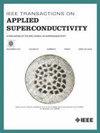Development of Electrically Conductive Buffer for REBCO Conductors
IF 1.7
3区 物理与天体物理
Q3 ENGINEERING, ELECTRICAL & ELECTRONIC
引用次数: 0
Abstract
An electrically conductive buffer architecture can enable defect-tolerant RE-Ba-Cu-O (REBCO) superconductor tapes by providing a current shunt path to the substrate. We are developing suitable electrically conductive buffers based on Titanium Nitride (TiN) grown on an ion beam-assisted deposition (IBAD) template on Hastelloy C276 substrate. The aim is to prevent the oxidation of TiN during metal-organic chemical vapor deposition (MOCVD) of REBCO. The buffer architecture was modified to render TiN more oxidation-resistant while maintaining good electrical conductivity. A strong biaxial texture was achieved and a low electrical resistivity of 43 µΩcm was measured with this modified buffer architecture. An oxide layer based on the SrTiO3 (STO) cap layer was epitaxially grown using RF magnetron sputtering followed by REBCO film growth by MOCVD. By avoiding oxidation of the modified buffer architecture based on TiN, we achieved a strong epitaxy of REBCO with a sharp texture, without non-00L orientations. Scanning Hall Probe Microscopy (SHPM) data showed uniformly high critical current density throughout the entire REBCO tape.求助全文
约1分钟内获得全文
求助全文
来源期刊

IEEE Transactions on Applied Superconductivity
工程技术-工程:电子与电气
CiteScore
3.50
自引率
33.30%
发文量
650
审稿时长
2.3 months
期刊介绍:
IEEE Transactions on Applied Superconductivity (TAS) contains articles on the applications of superconductivity and other relevant technology. Electronic applications include analog and digital circuits employing thin films and active devices such as Josephson junctions. Large scale applications include magnets for power applications such as motors and generators, for magnetic resonance, for accelerators, and cable applications such as power transmission.
 求助内容:
求助内容: 应助结果提醒方式:
应助结果提醒方式:


